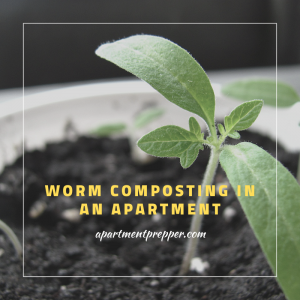Editor’s note: Before I started my journey of becoming more self-sufficient, I never would have considered trying to compost in an apartment. But since I have tried all sorts of projects I did not think were doable in an apartment such as food dehydrating, soap making and more, I realized the possibilities are endless. Today’s guest post offers some great tips on worm composting.
Help the Planet and Your Plants with Worm Composting
Written by Brenda Darrah
Why Compost?
According to the EPA, 15.1 percent of municipal solid waste that was sent to landfills in 2015 was food waste. That may not seem like a big number, but it amounts to over 39.6 million tons. About 76 percent of food that could be composted goes to a landfill.
You might think that organic waste in landfills will biodegrade anyway, but that’s not the case. These materials need oxygen to biodegrade efficiently, and because landfills are so densely packed, there is no oxygen. So the organic material stays right there with all of the plastic and other nonbiodegradables.
Composting not only benefits the planet. It can help you grow your own food. Compost is rich with organic matter, which improves the soil for your plants. It improves the structure of the soil and adds microbes, allowing air, water, and nutrients to be more available to plants.
Well, this is great, you think, but you can’t do anything to stop sending food waste to landfills because you live in an apartment.
Not true at all.
Let’s Explore Some Options
If you live in an area that provides a composting service, you can collect your food waste in a compost bin and give it to the service to keep it out of landfills. However, there’s a fee for that, and you won’t be creating your own compost that you can use on your plants.
It’s so much better to do the composting yourself. You can do this!
Traditional home composting techniques are usually done outside in large bins or even a group of bins. Obviously, this isn’t practical in an apartment.
But you can easily compost in your apartment with a technique called worm composting, also known as vermicomposting.
Worms? What??
Don’t be alarmed by the thought of worms in your apartment. They’re kept in a container, and if you take a few simple steps to take care of the bin, you’ll have no odors.
There are two options to get started. You can purchase a bin, or you can create one yourself.
Get a Bin
There are many worm composting bins available. The 3-Tray Worm Factory is a nice size for an apartment. If you want to go with modern and aesthetically pleasing, you could try the Biovessel, which can fit on your counter. Another more simple option is the Urban Worm Bag.
Just remember when you’re shopping for a bin to get a worm composting bin, not just a plain compost bin. The standard compost bin is actually just a fancy bucket to keep your food waste before you send it to a bigger compost bin or a composting service.
Better Yet, Build Your Own
You can save money and possibly space by making your own worm composting bin. Here’s what you’ll need:
- Worms – Red wigglers and redworms are the best. You’ll want to buy them because they’re hard to identify. You might be able to get them at a local nursery or fishing supply store, and they’re also available online. Get two pounds of worms (about 2,000) for every pound of food waste you have per day.
- Bedding – Shredded cardboard, shredded paper or newspaper (just make sure there’s no colored ink or bleached white office paper), shredded leaves, coconut fiber, wood shavings or chips, chopped straw or hay, or sawdust.
- Two containers – Find two opaque containers, one that’s about 5 inches tall and one that’s about 15 inches tall.
- A drill – You’ll need to drill drainage and oxygen holes.
- About four 4-inch by 4-inch scraps of screen that will not rust
- Waterproof glue to apply the screen pieces to the containers.
Once you have the supplies, you just need to assemble the bin, add the bedding and worms, and start composting! The EPA has great instructions on how to make and maintain a DIY worm composting bin.
To avoid odors, be sure not to feed the worms too much. Once a week should be good. Also, occasionally stirring the compost will keep it oxygenated and odor-free.
In three to six months, you’ll be able to harvest the rich worm castings to use on your plants!
About the Author:
 Brenda Darrah is a freelance writer and a relentless knowledge seeker with expert research skills. She writes blog posts, articles, and other content about personal finance and personal growth/wellness. Learn more about Brenda at brendadarrah.com.
Brenda Darrah is a freelance writer and a relentless knowledge seeker with expert research skills. She writes blog posts, articles, and other content about personal finance and personal growth/wellness. Learn more about Brenda at brendadarrah.com.
Image by Quartzla from Pixabay



